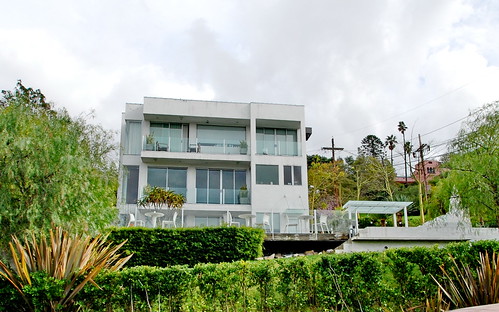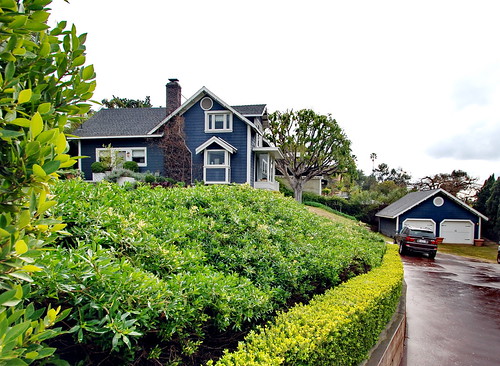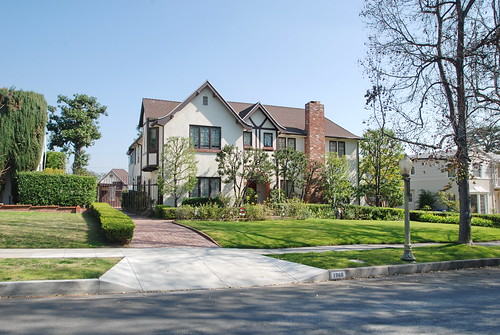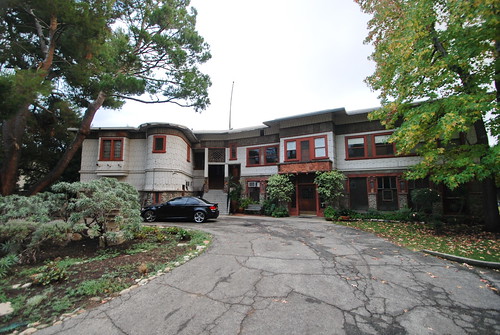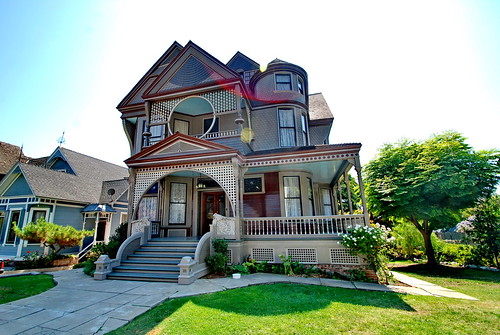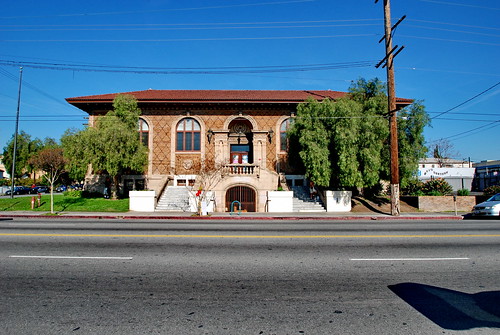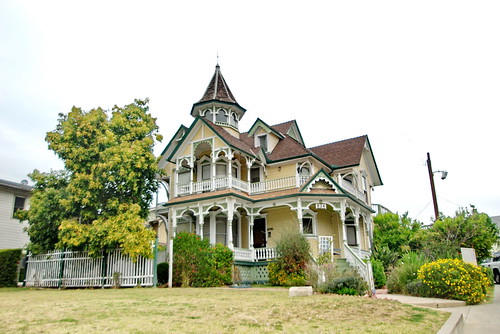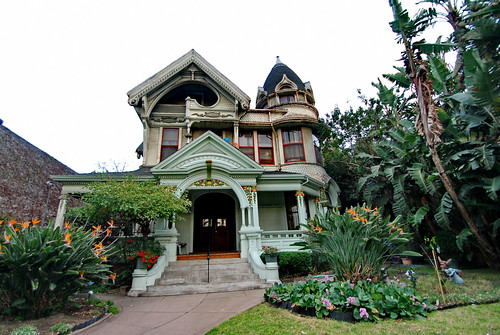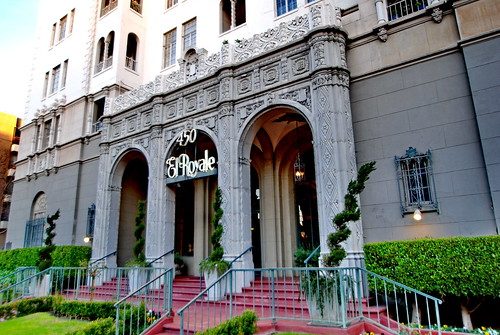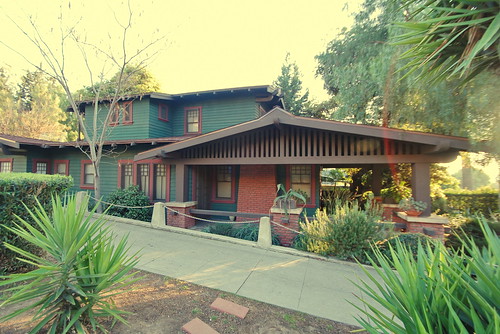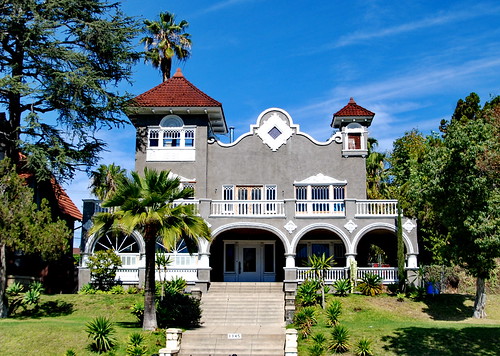I was delighted to "discover" the Mocine Duplex today, while taking photos for my upcoming book on the history of Silver Lake. Located within a stone's throw of the Neutra Colony, I thought at first it might actually be the work of Richard Neutra himself. With a little bit of research I was able to find out that the duplex was designed by a pair of architects with the appellation Farrell and Simpson; the team apparently worked in Richard Neutra's office in Silver Lake for a time.
Located at 2345 Cove Avenue in the Silver Lake neighborhood of Los Angeles.
Wednesday, February 20, 2013
Mocine Duplex, Farrell & Simpson, Architects 1951
Mike Valles Residence 2007
The contemporary home of Mike Valles, who along with his mother Lottie Valles founded the design firm Interior Illusions in 1999.
Located at 2359 Baxter Street in the Silver Lake neighborhood of Los Angeles.
Harry Hay House
The house where Harry Hay lived in Silver Lake, beginning in the 1940s. Henry "Harry" Hay, Jr. (1912 – 2002) was one of the original gay rights activists who founded the Mattachine Society, the first sustained gay rights advocacy groups in the United States.
Hay was a Marxist and a long-time member of the Communist Party USA. He also co-founded the Los Angeles chapter of the Gay Liberation Front in 1969, and later, the Radical Faeries. He died on October 24, 2002, following a series of illnesses. His Silver Lake house, originally built in 1905 is located at 2328 Cove Avenue. The stair street at the foot of the house has been renamed the Mattachine Steps in his honor.
Monday, February 18, 2013
Joseph Skirboll Residence, Lucius A. Phillips, Architect 1924
Architect-builder Lucius A. Phillips designed the English Revival style house for Joseph Skriboll in 1924. By 1930 the house was being rented by Corneilius G. Willis, a transplant and mining engineer from Washington, D.C.
Located at 1966 North Edgemont Street in the Los Feliz neighborhood of Los Angeles.
Joseph Skirboll Residence, Lucius A. Phillips, Architect 1924
Architect-builder Lucius A. Phillips designed the English Revival style house for Joseph Skriboll in 1924. By 1930 the house was being rented by Corneilius G. Willis, a transplant and mining engineer from Washington, D.C.
Located at 1966 North Edgemont Street in the Los Feliz neighborhood of Los Angeles.
Sunday, February 10, 2013
Bovard Administration Building, John & Donald Parkinson, Architects 1920-21
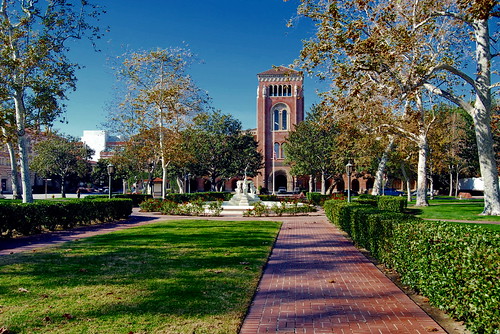
Bovard Administration Building, John & Donald Parkinson, Architects 1920-21, a photo by Michael Locke on Flickr.
The first Master Plan for the campus of the University of Southern California proposed in 1919 by Architect John Parkinson included a series of Italian Renaissance style buildings connected by a series of Romanesque style bridges that were to be built over the streets. Although the bridges were never realized, the Parkinsons completed a half dozen of these handsome edifices that defined the early architecture of the university.
The first of Parkinson's buildings to be completed was the George Finley Bovard Administration Building, in 1921. Described as 'northern Italian Romanesque style', the building's dominating feature is a square bell tower with eight heroic sculptures by John Caspar Lachne representing the 'Progress of Civilization'. The eight figures are of American Presidents Abraham Lincoln and Theodore Roosevelt, Roman orator and statesman Marcus Tullius Cicero and Greek philosopher Plato, John Wesley, Founder of Methodism, and three leading Methodist clergymen: Bishop Matthew Simpson, Preacher and College President; Phillips Brooks, the Fifth Bishop of Massachusetts and 158th in succession in the American episcopate, and a Methodist pastor and chair of Philosophy at Boston University.
Website:www.parkinsonarchitecture.com
Judson Studios, Train & Williams Architects 1900-1909
The Judson Studios is one of the oldest surviving stained glass studios in America, founded in 1897. The original building was designed in 1900 by William Lees Judson, founder of the Los Angeles College of Fine Arts in an Islamic Revival style. After the roof was destroyed by a fire in 1910, Architects Train & Williams redesigned the studio in 1909. Designated a Los Angeles Historic Cultural Monument in 1969 (NO. 62). Located at 200 S. Avenue 66 in the Highland Park Historic Preservation Overlay Zone of Los Angeles.
Please do not use this image in any media without my permission.
© All rights reserved.
Sessions House, Joseph Cather Newsom, Architect 1880
Designed for dairyman Charles Sessions by prominent architect Joseph Cather Newsom in 1880. One of the larges mansions and most imposing mansions on "Millionaire's Row". Located at 1330 Carroll Avenue in the Angelino Heights Historic Preservation Overlay Zone (HPOZ). Declared a Los Angeles Historic Cultural Monument in 1967 (No. 52).
McClure House, Joseph Cather Newsom, Architect 1889
The Victorian house was designed for W. McClure, a Director of the Garvanza Land Company, a developer in the region. The design has Queen Anne and Eastlake influences. Designated a Los Angeles Historic Cultural Monument (No. 107) in 1972. Located at 432 N. Avenue 66 in the Highland Park (Garvanza) Historic District of Los Angeles.
Please do not use this image in any media without my permission.
© All rights reserved.
Cahuenga Branch Library, Clarence H. Russell, Architect 1916
The Renaissance Revival style library was built with funds provided by the Carnegie Foundation. Located at 4591 Santa Monica Blvd. in the Hollywood neighborhood of Los Angeles. Declared a Los Angeles Historic-Cultural Monument in 1986 (No. 314).
Z.H. Weller Residence, Zachariah Weller, Builder c.1895
The house that contractor Zacharia Weller built for his family in 1894 is a fanciful example of Queen Anne architecture with Eastlake and Moorish influences thrown in for good measure. Born in Somerset County, Pennsylvania, on April 4, 1847, Zachariah Weller moved to Waterloo, Iowa, in 1864, where he worked as a building contractor and, later, a hardware merchant. Weller moved to Los Angeles in 1887 where he continued in the hardware trade, forming a partnership with E.A. Hoffman under the name Hoffman & Weller. The two entered the oil business together. In early 1893, Zach Weller bought from Charles Stimson a pair of lots in the Beauvoir Tract for $2,000. The home which was originally located at Angelina and Boylston was moved to its present location when oil wells began proliferating around the area. Weller died at the house on June 21, 1903 after a long illness.
The house was declared a Los Angeles Historic-Cultural Monument in 1979 (No. 223). Located at 824 E. Kensington Road in the Angelino Heights neighborhood of Los Angeles.
Please do not use this image in any media without my permission.
© All rights reserved.
Alphonse J. Forget Residence, Robert Brown Young, Architect 1890
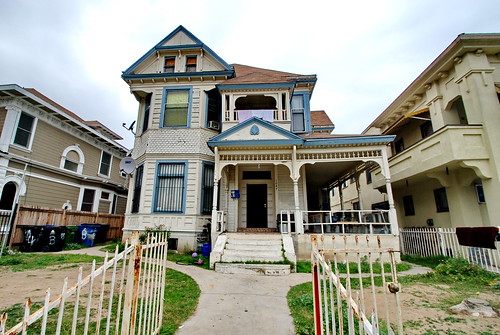
Alphonse J. Forget Residence, Robert Brown Young, Architect 1890, a photo by Michael Locke on Flickr.
The South Bonnie Brae Tract Historic District is a historic district of Victorian houses in Los Angeles, California, between the 1000 block of South Bonnie Brae Street and the 1800 block of West Eleventh Street, in the Pico Union Historic Preservation Overlay Zone (HPOZ) section of the city of Los Angeles.. The homes in the district date from the 1890s and reflect Queen Anne and Colonial Revival architecture. Based on its well-preserved period architecture, the district was added to the National Register of Historic Places in 1988. The Alphonse J. Forget House is a classic example of the Queen Anne Victorian style. The house is located at 1026 S. Bonnie Brae Street. Declared a Los Angeles Historic-Cultural Monument in 1989 (No. 433).
First Baptist Church- Allison & Allison, Architects 1927
Founded in 1884, the First Baptist Church of Los Angeles moved to its present location (the original church was located at 6th and Broadway) in 1927. The church is ornate by Baptist standards: the church's rose windows are adapted from the Chartres Cathedral; the coffered, gold-leaf ceiling is modeled after the chapel in the Ducal Palace in Montava, Italy. The 130-room edifice is dominated by the 155-foot Crowell Bell Tower, named after Weymouth Crowell, an imporant patron of the church.
Many important Angelinos have played a part in the history of the church. Landowner Isaac Lankershim was a trustee of the original congregation as well as his son-in-law. hotel owner and developer Isaac Newton Van Nuys.
The First Baptist Church of Los Angeles is located at 760 Westmoreland Avenue. It was declared a Los Angeles Historic-Cultural Monument (No. 237) in 1981.
Website:www.fbcofla.org
Wright-Mooers House c.1880
The Wright-Mooers House is representative of the "West Coast Victorian", an eclectic blend of Queen Anne Victorian with other styles, Note the small pairs of Romanesque columns and the elongated domed roof, perhaps a touch of the Islamic. The house was declared a Los Angeles Historic-Cultural Monument in 1967 (No. 45). The Located at 818 S. Bonnie Brae Street in the Westlake neighborhood of Los Angeles.
O'Neill Duplex, Rodney Walker, Designer, 1953; George Mimnaugh (Remodel) 2005
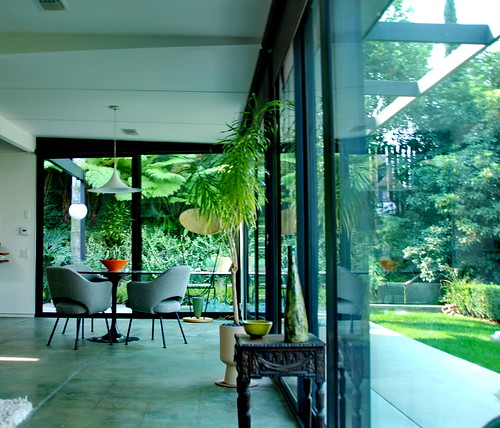
O'Neill Duplex, Rodney Walker, Designer, 1953; George Mimnaugh (Remodel) 2005, a photo by Michael Locke on Flickr.
Re-interpreted by Designer George Mimnaugh in 2005, these dramatic hillside units retain the original use of glass, concrete and wood with modern updates. Located at 2346-48 Cove Avenue in hills east of the Silver Lake Reservoir.
Declared a Los Angeles Historic-Cultural Monument in 2007 (No. 868)
Please do not use this image in any media without my permission.
© All rights reserved.
Campbell Divertimento Fountain, Luis Barragan & Raúl Ferrera, Architects 1996
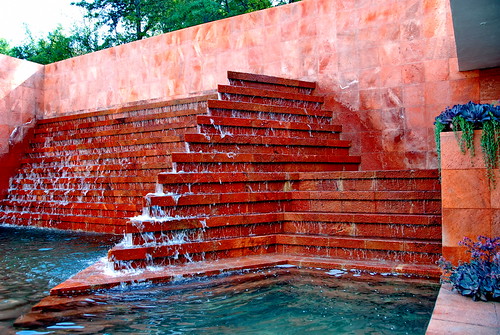
Campbell Divertimento Fountain, Luis Barragan & Raúl Ferrera, Architects 1996, a photo by Michael Locke on Flickr.
The Mayan-inspired Campbell Divertimento Fountain was designed by Luis Barragán, regarded as Mexico's greatest architect and his partner Raúl Ferrera. Although Barragan's participation in the project has been questioned, the names Barragán and Ferrera are clearly stamped on the blueprints dated 1987. (Reportedly only Ferrara signed them, however that was common practice for the period). The Los Angeles Cultural Heritage Commission recognized the fountain as "a signature project of Barragán, an architect of international fame and an architect of great importance to contemporary Mexican culture."
I had the pleasure of visiting the fountain in May 2008, thanks to an invitation from Architectural Designer Tim Campbell who had just completed restoration of the home.
The Fountain is located within a private residence at 1150 Brooklawn Drive. Declared a Los Angeles Historic-Cultural Monument in 1997 (No. 637).
Cinerama Dome, Welton Becket and Associates 1963
Welton Becket and Associates Architects designed the first geodesic dome theater based on a design by architect R. Buckminster Fuller. It was the first major motion picture theater in Hollywood in 33 years. Declared a Los Angeles Historic Cultural Monument (No. 659). Located at 6360 Sunset Boulevard.
Please do not use this image in any media without my permission.
© All rights reserved.
El Royale Apartments, William Douglas Lee, Architect c.1920
An elegant address in the upscale Hancock Park neighborhood of Los Angeles, the El Royale Aoartments were designed by architect William Douglas Lee in the 1920s. The historic building has French and Spanish Colonial Revival details; the front entrance is particularly imposing. Designated a Los Angeles Historic-Cultural Monument (No. 309) in 1986. Located at 450 N. Rossmore Avenue.
Charles C.L. Leslie Residence, Oliver P. Dennis & Lyman Farwell, Architects c.1910
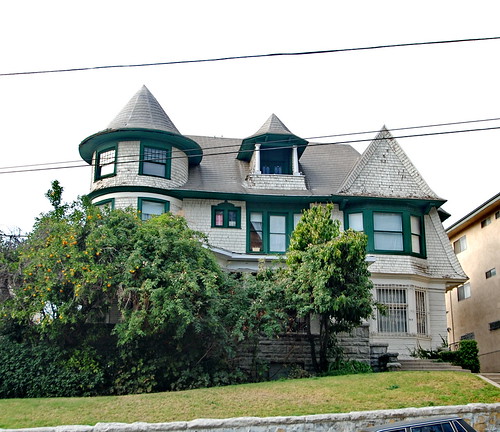
Charles C.L. Leslie Residence, Oliver P. Dennis & Lyman Farwell, Architects c.1910, a photo by Michael Locke on Flickr.
Architects Oliver P. Dennis and Lyman Farwell designed the Queen Anne style mansion for oil executive Charles C. L. Leslie in 1910. (Some sources indicate that Dennis may have originally built the house for himself). The firm was among the city's top architectural offices at the turn of the century, continuing up until the mid-teens, designing the Jans House (HCM# 227) and the Magic Caste (HCM# 406) both in Hollywood. Designated a Los Angeles Historic-Cultural Monument in 1974 (No. 129). Located at 767 S. Garland Avenue in the Westlake (MacArthur Park) neighborhood of Los Angeles.
Please do not use this image in any media without my permission.
© All rights reserved.
Château Élysée, Arthur E. Harvey, Architect 1927
The Château Élysée is an interpretation of a 17th Century Normandy castle, designed by Arthur E. Harvey for Eleanor Ince, widow of Thomas H. Ince, a pioneer filmmaker who died in 1924. Originally built as a luxury long-term residential apartment for movie stars including Bette Davis, Errol Flynn (room 211), Edward G. Robinson (room 216), Carol Lombard (room 305), Edgar Rice Burroughs (room 408), Humphrey Bogart (room 603), Clark Gable (room 604), Ginger Rogers (room 705), Ed Sullivan (room 501), Gracie Allen and George Burns (room 609) along with Lillian Gish, Katharine Hepburn, George Gershwin, and Cary Grant. The Manor, as it became known, was the scene of glamorous parties during the late 1920s and early 30s; it operated like a hotel with daily maid service and meals served in an elegant dining room on the premises. Since 1973, it has been owned by the Church of Scientology as the "Celebrity Centre". Declared a Los Angeles Historic-Cultural Monument in1987 (No. 329). Located at 5930 Franklin Avenue in Hollywood, California.
Kinney-Everhardy House, Sumner Hunt & Wesley Eager Architects 1902
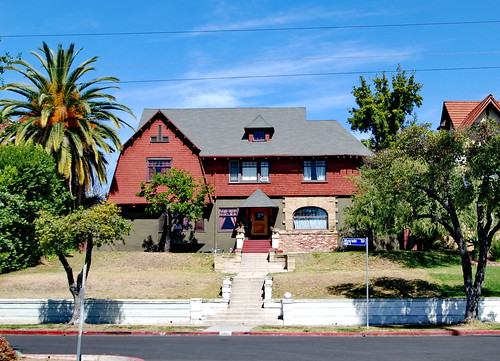
Kinney-Everhardy House, Sumner Hunt & Wesley Eager Architects 1902, a photo by Michael Locke on Flickr.
Designed by Sumner P. Hunt & Wesley Eager in 1902 for A.W. Kinney, a prominent Angelino businessman. It is one of the half dozen elegant mansions on Alvarado Terrace, promoted by real estate developer Pomeroy Powers who was President of the Los Angeles City Council from 1900 to 1904.
Declared a Los Angeles Historic-Cultural Monument in 1971 (No, 88). Located at 1401 Alvarado Terrace in the Pico Union neighborhood.
August House c.1913
One of Maltman Avenue's fine Craftsman style homes, the August House was designated a Los Angeles Historic-Cultural Monument in 2001 (No. 699). Located at 1664 Maltman Avenue in the Silver Lake neighborhood of Los Angeles.
Powers Residence, Arthur R. Haley, Architect c.1904
Alvarado Terrace, just south of Pico Boulevard and east of Hoover Street has a half a dozen lovely period homes facing Terrace Park. Built in 1904 by Pomeroy Powers, President of the Los Angeles City Council from 1900-1904. Powers was a real estate developer who helped establish the small park across the street.
The Powers Residence was declared a Los Angeles Historic-Cultural Monument in 1971 (No. 86). Located at 1345 Alvarado Terrace in the Pico Union neighborhood of Los Angeles..

